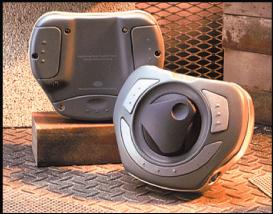
VuMan


Project Description
VuMan 1 allows a user to maneuver through the blueprints of a house
using three buttons for input. Output is provided on a commercially
available head-mounted display, the Private Eye, which gives the
illusion of viewing a personal computer screen from about five feet.
Composed of only five chips, VuMan 2 allows the user to move a cursor
across the display and select items from either a map, image database,
or textual database. New applications can be loaded into VuMan 2 by
inserting a different Flash EPROM memory card into the PCMCIA slot.
VuMan 2 represented a factor of four reduction in complexity, weight,
volume, and power consumption over VuMan 1 but with an increase of
over a factor of two in capability and a reduction of 40% in
design/fabrication effort. VuMan 2's main applications are a CMU
Campus Tour navigation and Maintenance Assistant. VuMan 2R is a
ruggedized version of VuMan 2. It incorporates a new housing design to
withstand shock, temperature, water, and dirt. Its printed circuit
board has some enhanced capabilities for input and power control.
VuMan 2R uses an input interface combined of a rotary dial and a
single push-button. The speed and easy for a user to scroll through
many options that may appear on a screen of the Private Eye display
are the reasons for the use of a rotary dial. A link is provided
between VuMan 2R and a Logistical Maintenance Computer (LMC) so that
results from vehicle inspection check lists can be uploaded for
scheduling and planning.
VuMan 3 has included enhanced capabilities
such as a higher performance processor, cache memory, hardware power
management, and two PCMCIA slots. In addition to a Flash memory card,
another PCMCIA device can be supported in a modular fashion, such as a
radio. Several converging design decisions that have were for VuMan 2R and
VuMan 3 contributed to shortening of their detailed design and implementation
phases, as part of that work has been overlapped.
A methodology is being developed for analyzing the power consumption
of mobile computers. This
methodology could be a precursor to system software which learns about
user habits and adapts the power management strategy. Mobile computers
have constraints that their desktop predecessors do not, especially in
the domains of size, weight, and power. The power consumed by a mobile
computer is a key constraint, because the power determines the amount
of batteries needed, which is a major factor in the minimum volume and
weight of the system. For example, in the VuMan 1, battery weight was
20% of the system weight; in the VuMan 2, it was 50% of the system
weight; and in Navigator 1, it was 70% of the system weight.

Last updated on
19 July 1997




